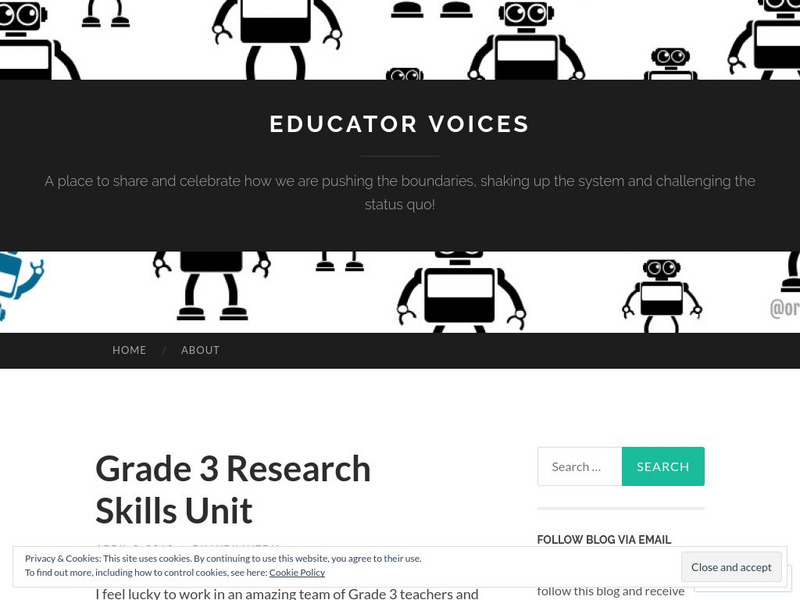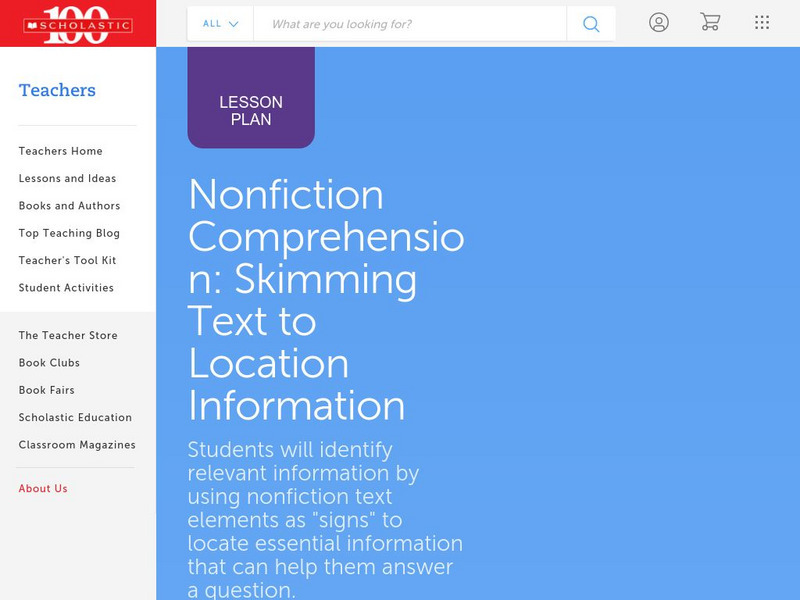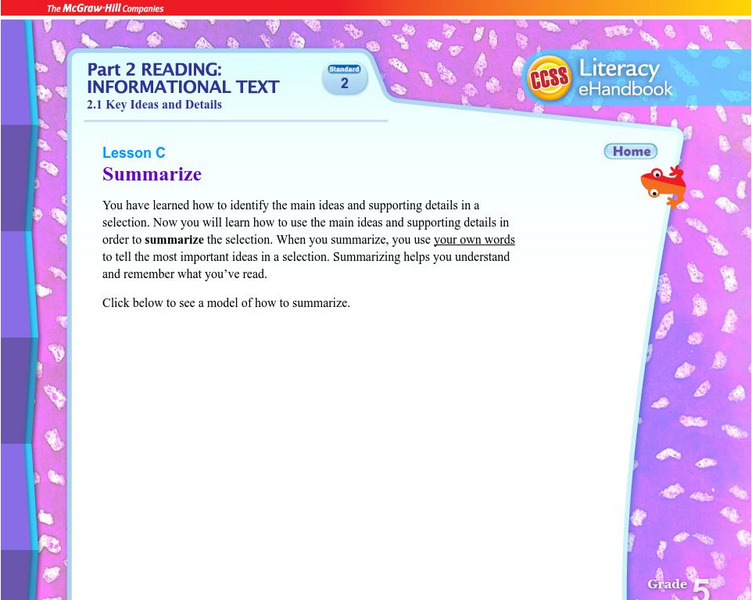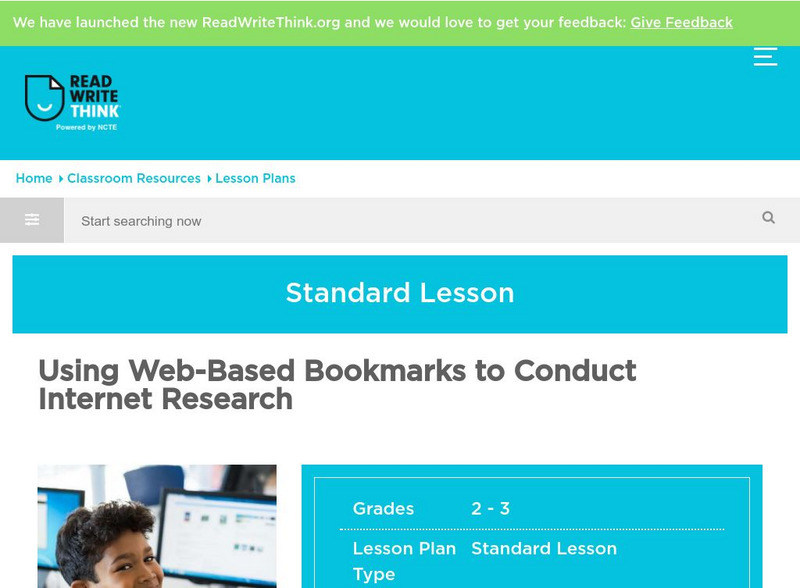Read Works
Read Works: 3rd Grade: Using Compare and Contrast Keywords: Lesson 1
[Free Registration/Login Required] With this lesson plan, teachers can help students increase their understanding of what they read through the use of key words that compare and contrast.
Cengage Learning
National Geographic: Informational Text and Young Children [Pdf]
Research-based informative article on when, why and how to introduce and teach reading skills with informational texts to early-elementary students beginning as early as kindergarten.
Wisconsin Response to Intervention Center
Wisconsin Rt I Center: Reading Resources [Pdf]
This site provides a collection of reading strategy teaching resources. Strategies are arranged according to the ELA Common Core Curriculum Standards and grade level bands.
Better Lesson
Better Lesson: Text Feature Diagrams
At the end of this instructional activity, students will be able to identify and create diagrams associated with informational text. Included is a link to an eSpark video on diagrams, rules for group work, multiple examples of diagrams,...
Utah Education Network
Uen: Cool Tools for Finding Information (Grade 3 4)
Identify text structures in various informational sources.
Other
Educator Voices: Grade 3 Research Skills Unit
Describes the process teachers went through to create a lesson unit where students first brainstormed what it means to do research, then were tasked with choosing a topic, researching it, and presenting on it several days later. The...
Scholastic
Scholastic: Lesson Plan for Nonfiction Comprehension: Skimming Text
Build comprehension by developing reading strategies for use with nonfiction text. This lesson focuses on teaching students to recognize text elements as clues to help them quickly locate key information in text.
SMART Technologies
Smart: Web Resources for 3 5 Reading and Language Intervention
Tons of online resources for reading and language skills compiled nicely into a student-friendly SMART Notebook file.
Beacon Learning Center
Beacon Learning Center: Web Lesson: Did I Read It: Implicit vs Explicit Details
Follow Carson through a lesson in order to become a better reader of informational text. Learn the difference between implicit and explicit information. Includes multiple interactive assessments and reading activities.
Curated OER
Mc Graw Hill: Part 2 Reading Informational Text: Understand Precise Vocabulary
Learn how to use context clues to help you define precise vocabulary words that you may not know.
Curated OER
Mc Graw Hill: Part 2 Reading: Informational Text: Connections Within Text
Learn how information in a text can be connected through compare and contrast, cause and effect, and sequence.
Curated OER
Mc Graw Hill: Part 2 Reading: Informational Text: Understand Content Words
A reference page that shows you how to use context clues to figure out the meaning of unknown content words.
Curated OER
Mc Graw Hill: Part 2 Reading: Informational Text: Summarize
Learn how to summarize a section of a text with this site.
Curated OER
Mc Graw Hill: Part 2 Reading: Informational Text: Understand Content Words
Understand how to use content words and context clues to identify unknown words in a reading passage.
Other
Kid Bibs: Effective Use of Textbook Features
Here, parents and teachers can find tips for helping young readers understand the expository writing found in textbooks.
ReadWriteThink
Read Write Think: K W L S Chart
A printable K-W-L-S sheet to help students activate prior knowledge, ask questions, record new learning, and then ask additional questions to extend inquiry beyond the text . Directions on how to use this type of graphic organize as well...
ReadWriteThink
Read Write Think: Making Connections
A printable graphic organizer for students to use when making text to self, text, and world connections while reading a text. Directions on how to use this type of graphic organize as well as lists of teaching ideas and related resources...
ReadWriteThink
Read Write Think: Nonfiction Pyramid
A printable pyramid for use with nonfiction texts while students identify the main ideas and supporting details within a text. Students also determine author's purpose and key vocabulary words. Directions on how to use this type of...
ReadWriteThink
Read Write Think: Using Web Based Bookmarks to Conduct Internet Research
The important thing about this lesson is that it connects literature and science. The Important Book by Margaret Wise Brown provides a model for original student poems about a content area topic. Web-based bookmarks guide young scholars...
ReadWriteThink
Read Write Think: Research Building Blocks: Skim, Scan, and Scroll
Contains plans for two lessons on locating supporting details that are part of a larger unit on researching a state symbol. It works on skills like determining the most important information, using key words to identify relevant...
ReadWriteThink
Read Write Think: Guided Comprehension: Making Connections
Lesson introduces young scholars to the strategy of making connections. Students learn the three types of connections using a double-entry journal. A good resource for teachers.
Curated OER
Mc Graw Hill: Part 2 Reading: Informational Text: Compare Text Structures
Compare the text structures in two nonfiction passages in this tutorial.
Read Works
Read Works: Genre Studies: Informational Texts: Pictures and Photographs
[Free Registration/Login Required] Lesson uses All About Cats and Kittens by Emily Neye to teach students how to identify facts from photographs and pictures in informational text. Ideas for direct teaching, guided practice, and...
Curated OER
Mc Graw Hill: Part 2 Reading: Comparison and Contrast Text Structure
A reference article showing reading strategies to understand text structure of comparison and contrast.



![National Geographic: Informational Text and Young Children [Pdf] Professional Doc National Geographic: Informational Text and Young Children [Pdf] Professional Doc](https://d15y2dacu3jp90.cloudfront.net/images/attachment_defaults/resource/large/FPO-knovation.png)
![Wisconsin Rt I Center: Reading Resources [Pdf] Professional Doc Wisconsin Rt I Center: Reading Resources [Pdf] Professional Doc](https://content.lessonplanet.com/knovation/original/366736-5cd279998cc3cbb7d56ecae193218c44.jpg?1661510893)














